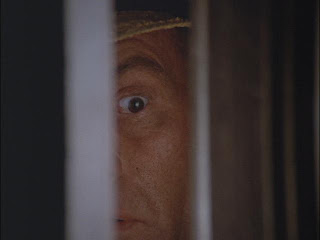 "Who said Bonnie Reynolds was thrown 22 feet into that culvert. The coroner? I haven't heard about it. Who said this new killing is connected to the Sheryl Hughes murder. The police? Not to me they haven't. Who said Sheryl Hughes died of massive blood loss. The coroner again? No. He hasn't even turned in his report yet. And who, may I ask, said a super-powerful madman is running loose in Las Vegas? Are you hearing voices again, Kolchak?"
"Who said Bonnie Reynolds was thrown 22 feet into that culvert. The coroner? I haven't heard about it. Who said this new killing is connected to the Sheryl Hughes murder. The police? Not to me they haven't. Who said Sheryl Hughes died of massive blood loss. The coroner again? No. He hasn't even turned in his report yet. And who, may I ask, said a super-powerful madman is running loose in Las Vegas? Are you hearing voices again, Kolchak?"As the 1960's rolled along, the notion of monsters went through a paradoxical paradigm shift, from scary and repulsive, to cute and cuddly and complete domestication, with the likes of The Munsters and The Addams Family saturating the airwaves -- even The Flinstones had themselves some new neighbors when the Gruesomes moved to Bedrock. Jumping on that bandwagon, producer Dan Curtis cashed in on this notion by taking vampires, werewolves, witches and other assorted ghouls to the last place you'd ever expect to find them -- in a soap opera, with those kooks from Collinwood lurking in all of those Dark Shadows. But by the 1970's, this premise was running on fumes, and finally sputtered and stalled-out after two theatrical versions of the same (House of Dark Shadows, Night of Dark Shadows) failed to generate enough buzz for a third. But when the series finally closed up its coffin lid for good in 1971, turns out Curtis wasn't done telling vampire stories yet. Not even close.




















Finding the near perfect vehicle in The Kolchak Papers, an unpublished novel by Jeff Rice, Curtis loved the contemporaneous notion of a serial killer stalking the neon streets of Las Vegas; a killer whose modus operandi is tearing out his victim's throat and making all of their blood disappear. Call me crazy, But that sounds like some kook who thinks he's a vampire, right? Well, that's exactly what a certain wry and acerbic reporter thinks, too, as he doggedly pursues the story. And through him, we watch as the evidence mounts -- evidence that can only be described as supernatural, and the authorities, despite their best efforts, fail to stop the murderer as the bodies keep piling up -- Kolchak (McGavin) comes to the only conclusion possible: the killer doesn't have to think he's a vampire when he really IS a vampire. Of course those same authorities don't buy it, or, more than likely, don't want to, even going so far to presciently cite Amity's Mayor Vaughn, chapter and verse. (Gentlemen, I believe you are going to ignore this problem until it creeps up and bites you on the neck!) But we know better. And so does our new age crusader, who, in his armor of seer-sucker blue, sneakers, and ratty porkpie hat, mounts his trusty steed (-- a Mustang convertible), takes up his cross and sword (-- make that a stake and hammer), and heads into the night, searching for an unspeakable monster in need of being put down for good -- hopefully, before the next edition's deadline!
__ __ __ __ __ __ __ __ __ __ __ __ __ __ __ __ __ __
If I were to assign credit for the character of Kolchak, I would say that Rice sculpted him, [Richard] Matheson smoothed out some of the edges, and McGavin breathed life into him!-- Dr. SkySkullxxxxx
__ __ __ __ __ __ __ __ __ __ __ __ __ __ __ __ __ __
That's a pretty good assessment there, but, truthfully, from what I read, as much I love him, Matheson didn't change a whole lot from Rice's novel when writing the screenplay, so I would add to that equation, and one cannot overlook, the contribution of the square, cinematic-eye of prolific TV director John Llewellyn Moxey, who crafted himself a taut, no-nonsense thriller. Mention should also be made for the fine supporting cast, stocked with rock-solid character actors (Meeker, Akins, Oakland). And a special nod to Atwater, who silently impends the menace as he buzzsaws through countless victims and police officers -- but saves the best for last, when he meets his doom and reveals what a truly pathetic creature Janos Skorzeny is in the light of day. The tele-feature is also a showcase for the city of Las Vegas, itself, a nice time capsule of Sin City before the era of mega-resorts irrevocably changed the skyline to something more akin to Disneyland. And if one thing is noticeably absent from the novel and the screenplay is a mob element, whom I'm sure would have been involved in some sense to take out the killer themselves since having a serial killer in town is definitely bad for business. But not for Curtis and Co. Again: not even close.

The Night Stalker (1972) Dan Curtis Productions~American Broadcasting Company (ABC) / P: Dan Curtis / D: John Llewellyn Moxey / W: Richard Matheson, Jeff Rice (Novel) / C: Michel Hugo / E: Desmond Marquette / S: Darren McGavin, Carol Lynley, Simon Oakland, Ralph Meeker, Claude Akins, Barry Atwater

No comments:
Post a Comment